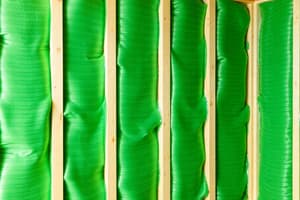Podcast
Questions and Answers
Which insulation type has the lowest thermal conductivity?
Which insulation type has the lowest thermal conductivity?
- EPS
- XPS (correct)
- GPS
- None of the above
What is a primary advantage of XPS over EPS insulation?
What is a primary advantage of XPS over EPS insulation?
- Lower cost
- Higher moisture resistance (correct)
- Easier to handle
- Lightweight nature
Which insulation material is generally more environmentally friendly?
Which insulation material is generally more environmentally friendly?
- EPS (correct)
- XPS
- GPS
- None of the above
What is the density range of EPS insulation?
What is the density range of EPS insulation?
Which insulation type is most likely to absorb moisture?
Which insulation type is most likely to absorb moisture?
For applications requiring high compressive strength, which insulation is preferred?
For applications requiring high compressive strength, which insulation is preferred?
What additional material is present in GPS to enhance its thermal insulation properties?
What additional material is present in GPS to enhance its thermal insulation properties?
Which of the following is true about the thermal performance of GPS compared to EPS?
Which of the following is true about the thermal performance of GPS compared to EPS?
What is the Canadian Standard Form of Contract primarily used for?
What is the Canadian Standard Form of Contract primarily used for?
Who developed the Canadian Standard Form of Contract?
Who developed the Canadian Standard Form of Contract?
The contract becomes an authorized copy when an authorization seal is __________.
The contract becomes an authorized copy when an authorization seal is __________.
The Canadian Standard Form of Contract includes terms for construction management.
The Canadian Standard Form of Contract includes terms for construction management.
Which of the following pages would you find definitions related to the contract?
Which of the following pages would you find definitions related to the contract?
What is included in the General Conditions of the contract?
What is included in the General Conditions of the contract?
How many pages are dedicated to the General Conditions?
How many pages are dedicated to the General Conditions?
Flashcards are hidden until you start studying
Study Notes
Expanded Polystyrene (EPS)
- Made from expanded polystyrene beads fused together.
- Thermal Conductivity: 0.032 - 0.038 W/m·K.
- Density: 15-25 kg/m³.
- Water Resistance: Less resistant to water absorption than XPS.
- Applications: Residential and commercial buildings for wall and roof insulation, in panels, blocks, and loose-fill applications.
- Advantages: Cost-effective, lightweight, easy to handle, good thermal performance.
- Disadvantages: Lower moisture resistance, less durable under high compressive loads.
Extruded Polystyrene (XPS)
- Made by extruding polystyrene foam, which forms a closed-cell structure.
- Thermal Conductivity: 0.029 - 0.035 W/m·K.
- Density: 30-50 kg/m³.
- Water Resistance: Very low water absorption due to its closed-cell structure.
- Applications: Below-grade insulation (foundations, basement walls), in areas exposed to moisture, insulation for roofs, walls, and under concrete slabs.
- Advantages: Excellent moisture resistance, higher compressive strength than EPS, good thermal performance.
- Disadvantages: More expensive than EPS, less environmentally friendly.
Graphite Polystyrene (GPS)
- Similar to EPS but with graphite added to improve thermal insulation properties.
- Thermal Conductivity: 0.031 - 0.033 W/m·K, lower than EPS due to the presence of graphite.
- Density: 20-30 kg/m³.
- Water Resistance: Comparable to EPS, not as resistant as XPS.
- Applications: Similar applications as EPS, including residential and commercial buildings.
Canadian Standard Form of Contract for Architectural Services
- This document is the 2018 edition of the Canadian Standard Form of Contract for Architectural Services, Document Six
- In this document, the term "Architect" refers to an individual or firm providing architectural services
- The document is protected by copyright and has been developed by the Royal Architectural Institute of Canada (RAIC) on behalf of the architectural profession in Canada
- The document is comprised of an Agreement, Definitions, General Conditions and Schedules
- Each section is detailed, with the information presented in a clear and concise manner
- This document outlines the responsibilities, rights, and obligations of both the Architect and the Client
- The document is intended to be a standardized contract for architectural services
- Provincial Association of Architects can be contacted regarding the application and use of this document
- Suggestions and feedback on the development of this document should be forwarded to the Royal Architectural Institute of Canada
Studying That Suits You
Use AI to generate personalized quizzes and flashcards to suit your learning preferences.




